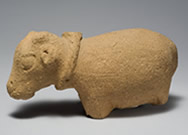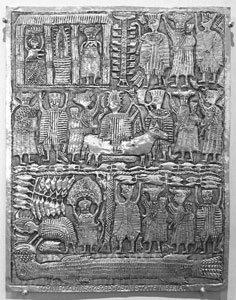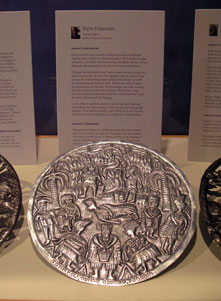Lakal's Posts
Nairaland Forum / Lakal's Profile / Lakal's Posts
(1) (2) (3) (4) (5) (6) (7) (8) (9) (10) (11) (of 12 pages)
Yoruba-style Sword ("Ida"   1 Like |
Axe for Shango (Oshe Shango) [img]http://t1.gstatic.com/images?q=tbn:ANd9GcTzyBlCiz0pEUkzh2cbRPNoKQssGGy-ttJGKizO5XtpfPMPqZtj[/img] Oshe Shango Yoruba, Republic of Benin Wood, indigo, bluing, lime, ochre. Fowler Cultural Museum of History On this dance wand, Oshe Shango, is an image of a kneeling female balancing on her head the double headed ax, representing the power of Shango. This wand is carried by the devotees of the orisha (god) Shango, the thunder god, at the yearly festival for their god and at other ritual festivals. It is one's ori , representing both their head and personal destiny, to carry the great power of Shango upon their head. |
[img]http://t2.gstatic.com/images?q=tbn:ANd9GcTQ7kw4dA4EYCTnsoOmdfKi_hkMVeue1UPHR_xvsj_yoIohwYwLWg[/img] Yoruba Ivory ceremonial Sword (Udamalore) - GDC.019 Origin: Nigeria Circa: 1800 AD to 1920 AD Dimensions: 15.25" (38.7cm) high Collection: African Art Style: Yoruba Medium: Ivory Condition: Extra Fine |
[img]http://t1.gstatic.com/images?q=tbn:ANd9GcR3UXBRVlXTHJVuV2bkHlwFAoGqrUfbyHe_ynKTR49a1d7NsZ2e[/img] Yoruba ceremonial swords. |
Weaponry! Ceremonial and real   Origin: Nigeria Circa: 20 th Century AD Dimensions: 18" (45.7cm) high Collection: African Style: Yoruba Medium: Brass |
^^ That still goes along with what I'm saying. Every Yoruba myth states that their founders came from the East. The Ijebus (or rather ,the Awujale) are just saying that they got to their present location first. |
Interesting viewpoints for both sides: After World War II, Jamaicans purchased radios in increasing numbers and were able to hear rhythm and blues music from Southern United States cities such as New Orleans by artists such as Fats Domino and Louis Jordan. Ska combined elements of Caribbean mento and calypso with American jazz and rhythm and blues. It is characterized by a walking bass line accented with rhythms on the upbeat. In the early 1960s, ska was the dominant music genre of Jamaica and was popular with British mods And what was their style? |
Modern palace entrance, Oyo.  |
The first one was collected in the mid 20th Century, no notes on when it was made. The second dates from the 19th Century. |
Another example of a carved calabash. [img]http://images.tribe.net/tribe/upload/photo/8a1/7c9/8a17c909-0045-4713-ac4f-365b8d4e36e9[/img] 1 Like |
Carved Yoruba calabash [img]http://hearstmuseum.berkeley.edu/exhibitions/maker/images/5_15649ab.jpg[/img] In Yoruba culture, the calabash is considered a container for items, both sacred and profane, but importantly is a symbol used when explaining the universe, which is considered to be a calabash (again, science concurs that the universe as we understand it is in essence an expanding sphere). In that role, the universe is cut in half with the upper half representing Orun (heaven) and the lower half representing earth or the “known” universe (aiye). This plays directly into our diagram of circle with two intersecting lines, the horizontal representing the differentiation between heaven and earth and subsequently life and death. 2 Likes |
Ifa Diviner's necklace (Ikolaba Ifa) [img]http://zoom.mfa.org/fif=sc8/sc8631.fpx&obj=iip,1.0&wid=568&cell=568,427&cvt=jpeg[/img] |
@Ileke_idi -- horses were very prominent in the Savanna regions of Yorubaland, epecially Oyo. Horses were closely tied to Kings and nobility, and were the symbols of the Oyo Empire's might. Only the very wealthy could keep horses as most of Yorubaland is inhospitable to the horse because of the tsetse fly. Therefore, horses were an expensive prestige object. It was horses that allowed Oyo to aggressively expand. Remember Wole Soyinka's play Death and the King's Horseman? That is one instance of the importance of the horse to the culture of (Northwestern) Yorubaland. |
Part of an Oba's royal attire: fully beaded footwear (19th Century).  Beaded slippers were part of the regalia worn by the Yoruba king (oba) when he appeared in public ceremonies. Beaded shoes became popular in the eighteenth or nineteenth centuries when European fashion became the model for prestige wear and Yoruba leaders began to move freely outside of the palace. Rulers created laws prohibiting commoners from wearing shoes and other items associated with royalty. When the king is greeted in Yoruba society, people say, “May the crown rest long on your head, may shoes remain long on your feet.” |
Epa Mask, Ekiti Region. Mounted Horseman (jagunjagun) [img]http://t1.gstatic.com/images?q=tbn:ANd9GcS0BOQXjINJIIDj5kjqx4BFOTXgkOfqqWsvy9WqWdMo-UCs1j5vfLy3tfDfZA[/img] |
 The unusual carving discussed here is of a bearded rider holding the reins in his left hand. He is wearing a short-sleeved tunic and breeches, his coiffure dressed as a long, interlaced pigtail falling to the horse's rump, with white painted eyes, and a sheathed broadsword at the left hip. The horse has a halter carved as rectangular-link chain, its legs clustered on the small, pierced, rectangular base, and painted spots on the saddle cloth. This figure takes the form of an Oyo-Yoruba cavalryman of the highest military grade. It may indeed be a representation of the alafin (king) of Oyo's commander-in-chief ("the esho of the eshos"  , of whom the Yoruba Samuel Johnson wrote a century ago in his The History of the Yorubas (C.M.S., Lagos, 1921; reprinted 1937). This supremo's office was created about the end of the seventeenth century when the might of Oyo was growing and winning the city prominence in the Atlantic trade. , of whom the Yoruba Samuel Johnson wrote a century ago in his The History of the Yorubas (C.M.S., Lagos, 1921; reprinted 1937). This supremo's office was created about the end of the seventeenth century when the might of Oyo was growing and winning the city prominence in the Atlantic trade.1 Like 1 Share |
PhysicsQED: Unfortunately, no! At least none that aren't extremely stylized. I'm still searching, however. You know there is one Benin bronze that is either said to represent a Yoruba horseman, or a warrior from Idah. That's another possibility. |
I iwsh they had pictures of the Olowo of Owo's palace, the largest palace in Africa. The largest courtyard in that palace is said to be twice the length of an American football field!  |
Traditional Yoruba house plan. The Yoruba house was centered around courtyards; most daily life and activities took place in the courtyard, with rooms reserved for sleeping. Courtyards had large jars for collecting rainwater, and had drainage to stop damage from excess water. [img]http://www.pitt.edu/~natrooms/africa/T3c_files/image002.gif[/img] |
Palace under construction.  |
The following images come from the expedition of Leo Frobenius to Southern Nigeria in 1910-12. Frobenius is famous for ascribing an "Atlantean" origin to the Ife bronzes. Kabiyesi o!  |
 African, Nigeria, Owo, Yoruba people Horse and Rider (Jagunjagun Eleshin), probably 17th-18th century, wood. A mounted warrior dressed in body armor and a large helmet sits straight up on his horse with his javelin poised to attack. The lines on his face exaggerate a terrible gaze that is intended to strike fear into the hearts of his foes. Based on this decoration we can determine that the invader is from the northern kingdom of Oyo in Yorubaland and is part of the force that invaded the southern Owo region in the seventeenth and eighteenth centuries. This piece was likely commissioned as an altarpiece dedicated to Ifa, the god of divination. The unknown sculptor uses intricate carving and zigzag patterns to create detail and character in the clothing, armor and tack on the horse and rider. The sculptural style indicates that it was created in the southern Owo region. Clearly the invaders from the north made a deep impression on the artist and the people who created this piece. |
 Torso with beaded necklaces, Ife, Igbo Kubolaje. Terracotta, 12th-14th century.  Bracelet of birds pecking at bound humans, Ife, brass, 14th-15th century.  Ram figure, Osangangan Obamakin, Ife. Terracotta, 12th-15th century. |
 Quartz stool from shrine at Oluorogbo, Ife, Nigeria, now in British Museum, London, United Kingdom This also appears to be a stool? [img]http://hum.lss.wisc.edu/hjdrewal/ife_new_4_jthu.jpg[/img] |
[img]http://hum.lss.wisc.edu/hjdrewal/Ife3.jpg[/img] Ife terracotta. Child of Obatala (creation divinity). The sculpture probably depicts a ritual specialist indicated by the bead on his forehead and the skull pendant. 2 Likes |
Artist Toyin Folorunso works in aluminum, using traditional Yoruba style:  Mr. Folorunso also designed the medal for former U.S. President Clinton's "Clinton Global Initiative."  2 Likes |
A major venue for the modern-day works of Yoruba artists to be displayed is the annual Osun Osogbo festival, held at the Osun Osogbo grove, a UNESCO world Heritage site. Artist's depiction of the "Arugba Osun" or maiden that leads the Osun festival's procession.  (Sidenote: Tunde Kelani of Mainframe Productions also made a movie entitled "Arugba"   1 Like |
The doors of the African Room at the Kennedy Center In Washindgton, D.C.  |
PAGAN 9JA: Yes there still are. The Fakeye family is a multigenerational group of modern Yoruba sculptors. Lamidi Fakeye (1928-2009) carved the doors of the African Room at the Kennedy Center in Washington, D.C. Other prominent sculptors are Akin Fakeye (b. 1936) Azeez Kayode Fakeye (b. 1965) and Lukman Fakeye (B. 1983) 2 Likes |
Where did the Awujale say that the Ijebus are not Yorubas? It seems to be more of what I stated in the last sentence of my first post, that the Ijebu believe that their culture predates Oduduwa. |
In comparison, normal houses (and a kitchen?) from that time period in Abeokuta. Olumo Rock is in the background. [img]http://csweb.bournemouth.ac.uk/africanlegacy/images/olomu_rock.jpg [/img] |
(1) (2) (3) (4) (5) (6) (7) (8) (9) (10) (11) (of 12 pages)
(Go Up)
| Sections: politics (1) business autos (1) jobs (1) career education (1) romance computers phones travel sports fashion health religion celebs tv-movies music-radio literature webmasters programming techmarket Links: (1) (2) (3) (4) (5) (6) (7) (8) (9) (10) Nairaland - Copyright © 2005 - 2024 Oluwaseun Osewa. All rights reserved. See How To Advertise. 37 |

